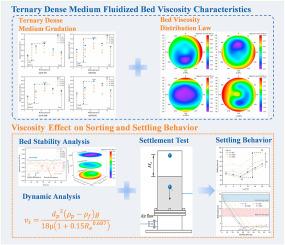三元重介质高密度气固流化床油页岩分离性能及表观粘度特性
IF 4.3
2区 材料科学
Q2 ENGINEERING, CHEMICAL
引用次数: 0
摘要
高效干法分离是低品位油页岩开发利用的关键。本研究以硅铁粉、磁铁矿粉和d级油页岩颗粒为原料,建立了三元高密度气固流化床系统,重点研究表观粘度对颗粒沉降的影响。结果表明,粘度受介质组成、颗粒大小和流动结构的影响。在B -硅和B+磁铁矿二元体系中,当硅铁比为40%时,粘度最小(0.782 Pa s)。在三元体系中,粘度随油页岩含量的增加呈非线性增加,流化稳定性下降的临界阈值为8%。气速对粘度分布有显著影响,适度增加气速可改善流动均匀性,使粘度降低32% ~ 40%。但速度过大导致气泡聚结,黏度波动增大,标准差从0.0065上升至0.0191 Pa s。沉降试验表明,低气速下,中床区分离效果最佳,高气速下,分离向上层转移。当气速大于0.45 m/s时,分离效率最佳。该研究阐明了粘度与分离性能的关系,为优化油页岩干式分离提供了指导。本文章由计算机程序翻译,如有差异,请以英文原文为准。

Oil shale separation performance and apparent viscosity characteristics in a ternary dense medium high-density gas–solid fluidized bed
Efficient dry separation is essential for utilizing low-grade oil shale. This study developed a ternary high-density gas–solid fluidized bed system using ferrosilicon powder, magnetite powder, and D-class oil shale particles, focusing on the impact of apparent viscosity on particle settling. Results showed that viscosity was influenced by medium composition, particle size, and flow structure. In the binary system of B− silicon and B+ magnetite, minimum viscosity (0.782 Pa s) was reached at a 40 % ferrosilicon ratio. In the ternary system, viscosity increased nonlinearly with oil shale content, with 8 % being the critical threshold where fluidization stability declined. Gas velocity significantly affected viscosity distribution, with moderate increases improving flow uniformity and reducing viscosity by 32 %–40 %. However, excessive velocity caused bubble coalescence and increased viscosity fluctuations, with standard deviation rising from 0.0065 to 0.0191 Pa s. Sedimentation tests showed that the middle bed region provided optimal separation at low gas velocity, while higher velocities shifted separation to the upper region. When gas velocity exceeds 0.45 m/s, the best separation efficiency is achieved. This study clarifies the relationship between viscosity and separation performance, providing guidance for optimizing dry oil shale separation.
求助全文
通过发布文献求助,成功后即可免费获取论文全文。
去求助
来源期刊

Particuology
工程技术-材料科学:综合
CiteScore
6.70
自引率
2.90%
发文量
1730
审稿时长
32 days
期刊介绍:
The word ‘particuology’ was coined to parallel the discipline for the science and technology of particles.
Particuology is an interdisciplinary journal that publishes frontier research articles and critical reviews on the discovery, formulation and engineering of particulate materials, processes and systems. It especially welcomes contributions utilising advanced theoretical, modelling and measurement methods to enable the discovery and creation of new particulate materials, and the manufacturing of functional particulate-based products, such as sensors.
Papers are handled by Thematic Editors who oversee contributions from specific subject fields. These fields are classified into: Particle Synthesis and Modification; Particle Characterization and Measurement; Granular Systems and Bulk Solids Technology; Fluidization and Particle-Fluid Systems; Aerosols; and Applications of Particle Technology.
Key topics concerning the creation and processing of particulates include:
-Modelling and simulation of particle formation, collective behaviour of particles and systems for particle production over a broad spectrum of length scales
-Mining of experimental data for particle synthesis and surface properties to facilitate the creation of new materials and processes
-Particle design and preparation including controlled response and sensing functionalities in formation, delivery systems and biological systems, etc.
-Experimental and computational methods for visualization and analysis of particulate system.
These topics are broadly relevant to the production of materials, pharmaceuticals and food, and to the conversion of energy resources to fuels and protection of the environment.
 求助内容:
求助内容: 应助结果提醒方式:
应助结果提醒方式:


